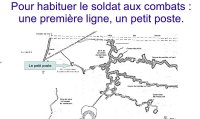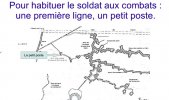- The front lines have mostly been formed originally in forest edges (Argonne etc.), as per instruction books. From January on, the first occupants had here to handle with the pick and the shovel and to learn how the "fortifications" for the Front should be made.
- We have a fairly accurate representation of the theater of operations for future soldiers over a hundred meters place. Shelters called "casemate" were dug in addition to the hoses and we have now to imagine them with their narrow access, built under a blanket of logs as well as a fairly consistent thickness of earth.
- Please note that this place is much more worn than the trenches called second line trenches (4 & 5) which are narrower. The place was intensive used both for the position and for the training of soldiers for the battle. They trained for going out to the load with their bayonet guns, probably armed with a breastplate full of blank munitions. Please try to imagine these fortifications maintained by weirs whose components were made with young trees collected on the plot.
- It seems that this plot failed to provide enough young trees, because the guard Henri Perthuisot, responsible for selection, noted on the 1st of February, 1916:
- "I was on tour in Canton Sablonnières and Ténières where I found that the military had cut small oaks and charms to construct weirs in the plot" ( 34)
- The whole site ended by Allée des Soldats, where instructors probably stayed (an almost parallel hose ending in a drainage ditch cutting the allée, is now almost filled)
- From this set, going in opposite directions, you can find the access to "Small post -10 " as well as the area with casemates for rest -2" and hoses called "up and down" leading to the " pool area -3".
 Site officiel de"Vallée de la Cisse" : étudier de manière pluridisciplinaire les questions culturelles et diffuser les résultats des recherches par divers moyens sur nos 18 communes fédérées de la Vallée
Averdon - Chambon-sur-Cisse - Chouzy-sur-Cisse - Coulanges - La-Chapelle-Vendômoise - Fossé - Landes-le-Gaulois - Marolles - Mesland - Molineuf - Monteaux - Onzain - Orchaise - St-Bohaire - St-Lubin-en-Vergonnois - St-Sulpice-de-Pommeray - Seillac - Veuves
Site officiel de"Vallée de la Cisse" : étudier de manière pluridisciplinaire les questions culturelles et diffuser les résultats des recherches par divers moyens sur nos 18 communes fédérées de la Vallée
Averdon - Chambon-sur-Cisse - Chouzy-sur-Cisse - Coulanges - La-Chapelle-Vendômoise - Fossé - Landes-le-Gaulois - Marolles - Mesland - Molineuf - Monteaux - Onzain - Orchaise - St-Bohaire - St-Lubin-en-Vergonnois - St-Sulpice-de-Pommeray - Seillac - Veuves
Home > A-LES SABLONNIERES, tranchées d’entraînement, field of fortifications, des (...) > La composition du terrain d’entraînement > 9 – The Front - First line with its casemates shelters

9 – The Front - First line with its casemates shelters
by
All the versions of this article: [Deutsch] [English] [français]
Translated by Nathalie GAUTHIER
An early work on the site was to create a line that looks like the front that "blue" soldiers called in December 1914 will have to tackle in spring 1915.
(vu par 193 visiteurs)
